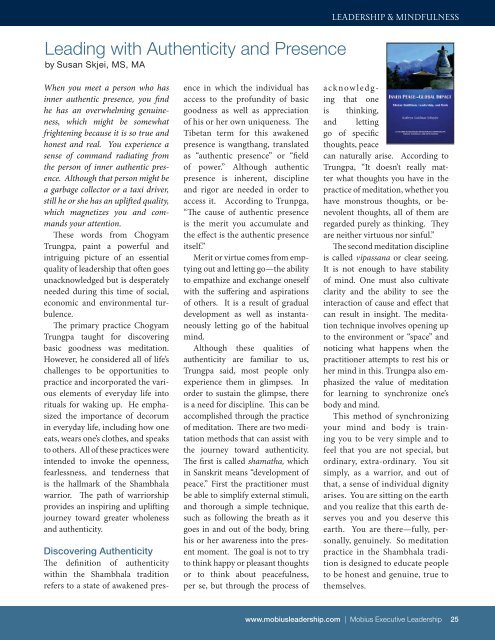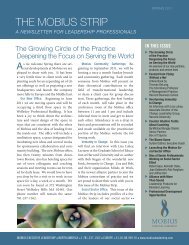LEADERSHIP & <strong>Mindfulness</strong>Chade-Meng TanMeng is Google’s Jolly Good Fellow (which nobodycan deny). As one of Google’s earliest engineers,Meng helped build Google’s first mobile searchservice and headed the team that monitoredGoogle’s search quality. After a successfuleight-year stint in engineering and two years asGoogleEDU’s head of personal growth, he currentserves Google’s talent team. Meng’s job descriptionis to “enlighten minds, open hearts and create worldpeace.” To learn more, go to www.siybook.com.ity of our emotional lives. That is thepromise of the science and practicesdescribed in these pages.Train AttentionHow do we begin training emotionalintelligence? We begin by trainingattention. This may seem a littlecounterintuitive at first. I mean, whatdoes attention have to do with emotionalskills? The answer is that astrong, stable, and perceptive attentionthat affords you calmness andclarity is the foundation upon whichemotional intelligence is built. Forexample, self-awareness depends onbeing able to see ourselves objectively,and that requires the ability toexamine our thoughts and emotionsfrom a third- person perspective, notgetting swept up in the emotion, notidentifying with it, but just seeing itclearly and objectively. This requiresa stable and clear, nonjudging attention.Another example shows howattention relates to self- regulation.There is an ability called “responseflexibility,” which is a fancy name forthe ability to pause before you act.You experience a strong emotionalstimulus, but instead of reactingimmediately as you normally would(for example, giving the other driverthe bird), you pause for a split second,and that pause gives you choicein how you want to react in thatemotional situation (for example,choosing not to give the other driverthe bird, which may save you a lot oftrouble because the other driver maybe an angry old man with golf clubswho turns out to be the father of thewoman you’re dating).That ability depends again on havinga quality of attention that is clearand unwavering. To quote ViktorFrankl, “Between stimulus and response,there is a space. In that spacelies our freedom and our power tochoose our response. In our responselies our growth and our happiness.”What a mind of calmness and claritydoes is to increase that space forus. The way to train this quality ofattention is something known as“mindfulness meditation.” <strong>Mindfulness</strong>is defined by Jon Kabat- Zinn as“paying attention in a particular way:on purpose, in the present moment,and non-judgmentally.” 11 The famousVietnamese Zen master Thich NhatHanh defined mindfulness very poeticallyas “keeping one’s consciousnessalive to the present reality,” 12 which Ireally like, but I found Jon’s definitioneasier to explain to the engineers,and I like the engineers. <strong>Mindfulness</strong>is a quality of mind that we all experienceand enjoy from time to time,but it is something that can be greatlystrengthened with practice, andonce it becomes sufficiently strong, itleads directly to the attentional calmnessand clarity that forms the basisof emotional intelligence. There isscientific evidence showing that improvingour ability to regulate ourattention can significantly impacthow we respond to emotions.An interesting study by neuroimagingresearcher Julie Brefczynski-Lewisand colleagues revealed that whenexpert meditators (those with tenthousand or more hours of meditationtraining) were subjected to negativesounds (for example, a womanscreaming), they showed lesser activationin the part of the emotionalbrain called the amygdala comparedto novice meditators. 13 Furthermore,the more hours of meditation trainingthe expert had, the lower theactivation in the amygdala. This isfascinating because the amygdala hasa privileged position in the brain—itis our brain’s sentinel, constantly scanningeverything we see for threats toour survival. ■Footnotes9. Katherine Woollett, Hugo J. Spiers, Eleanor A.Maguire, “Talent in the Taxi: A Model System forExploring Expertise,” Philosophical Transactionsof the Royal Society 364, no. 1522 (2009): 1407–1416. There is also a BBC News article, availableat: http://siybook.com/a/taxibrain.10. Unpublished data. Philippe Goldin, Ph.D.”Cognitive reappraisal of emotion after Cognitive-Behavioral Therapy for Social anxietydisorder.” Presented at the annual conferenceof the Association of Behavioral and CognitiveTherapy November 2008.11. Jon Kabat- Zinn, Wherever You Go, There YouAre: <strong>Mindfulness</strong> Meditation in Everyday Life(New York: Hyperion, 1994).12. Thich Nhat Hanh, The Miracle of <strong>Mindfulness</strong>:An Introduction to the Practice of Meditation(Boston: Beacon Press, 1999).13. J. A.Brefczynski- Lewis, et al., “Neural Correlatesof Attentional Expertise in Long- Term MeditationPractitioners,” Proceedings of the NationalAcademy of Sciences of the United States ofAmerica 104, no. 27 (2007): 11483–11488.24 <strong>Mobius</strong> <strong>Executive</strong> <strong>Leadership</strong> | www.mobiusleadership.com
Leading with Authenticity and Presenceby Susan Skjei, MS, MALEADERSHIP & <strong>Mindfulness</strong>When you meet a person who hasinner authentic presence, you findhe has an overwhelming genuineness,which might be somewhatfrightening because it is so true andhonest and real. You experience asense of command radiating fromthe person of inner authentic presence.Although that person might bea garbage collector or a taxi driver,still he or she has an uplifted quality,which magnetizes you and commandsyour attention.These words from ChogyamTrungpa, paint a powerful andintriguing picture of an essentialquality of leadership that often goesunacknowledged but is desperatelyneeded during this time of social,economic and environmental turbulence.The primary practice ChogyamTrungpa taught for discoveringbasic goodness was meditation.However, he considered all of life’schallenges to be opportunities topractice and incorporated the variouselements of everyday life intorituals for waking up. He emphasizedthe importance of decorumin everyday life, including how oneeats, wears one’s clothes, and speaksto others. All of these practices wereintended to invoke the openness,fearlessness, and tenderness thatis the hallmark of the Shambhalawarrior. The path of warriorshipprovides an inspiring and upliftingjourney toward greater wholenessand authenticity.Discovering AuthenticityThe definition of authenticitywithin the Shambhala traditionrefers to a state of awakened presencein which the individual hasaccess to the profundity of basicgoodness as well as appreciationof his or her own uniqueness. TheTibetan term for this awakenedpresence is wangthang, translatedas “authentic presence” or “fieldof power.” Although authenticpresence is inherent, disciplineand rigor are needed in order toaccess it. According to Trunpga,“The cause of authentic presenceis the merit you accumulate andthe effect is the authentic presenceitself.”Merit or virtue comes from emptyingout and letting go—the abilityto empathize and exchange oneselfwith the suffering and aspirationsof others. It is a result of gradualdevelopment as well as instantaneouslyletting go of the habitualmind.Although these qualities ofauthenticity are familiar to us,Trungpa said, most people onlyexperience them in glimpses. Inorder to sustain the glimpse, thereis a need for discipline. This can beaccomplished through the practiceof meditation. There are two meditationmethods that can assist withthe journey toward authenticity.The first is called shamatha, whichin Sanskrit means “development ofpeace.” First the practitioner mustbe able to simplify external stimuli,and thorough a simple technique,such as following the breath as itgoes in and out of the body, bringhis or her awareness into the presentmoment. The goal is not to tryto think happy or pleasant thoughtsor to think about peacefulness,per se, but through the process ofacknowledgingthat oneis thinking,and lettinggo of specificthoughts, peacecan naturally arise. According toTrungpa, “It doesn’t really matterwhat thoughts you have in thepractice of meditation, whether youhave monstrous thoughts, or benevolentthoughts, all of them areregarded purely as thinking. Theyare neither virtuous nor sinful.”The second meditation disciplineis called vipassana or clear seeing.It is not enough to have stabilityof mind. One must also cultivateclarity and the ability to see theinteraction of cause and effect thatcan result in insight. The meditationtechnique involves opening upto the environment or “space” andnoticing what happens when thepractitioner attempts to rest his orher mind in this. Trungpa also emphasizedthe value of meditationfor learning to synchronize one’sbody and mind.This method of synchronizingyour mind and body is trainingyou to be very simple and tofeel that you are not special, butordinary, extra-ordinary. You sitsimply, as a warrior, and out ofthat, a sense of individual dignityarises. You are sitting on the earthand you realize that this earth deservesyou and you deserve thisearth. You are there—fully, personally,genuinely. So meditationpractice in the Shambhala traditionis designed to educate peopleto be honest and genuine, true tothemselves.www.mobiusleadership.com | <strong>Mobius</strong> <strong>Executive</strong> <strong>Leadership</strong> 25



